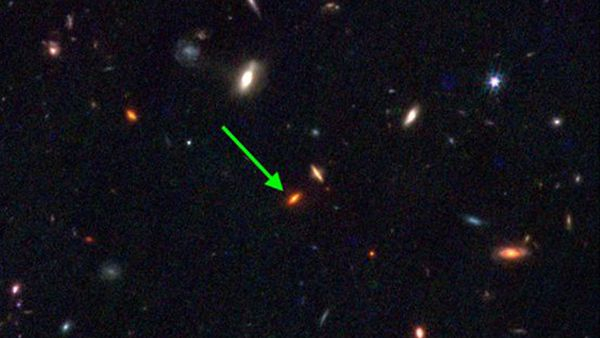The James Webb Space Telescope (JWST) has found a galaxy in the early universe that’s so massive, it shouldn’t exist, posing a “significant challenge” to the standard model of cosmology, according to the study authors.
The galaxy, called ZF-UDS-7329, contains more stars than the Milky Way, despite having formed only 800 million years into the universe’s 13.8 billion-year life span. This means they were somehow born without dark matter seeding their formation, contrary to what the standard model of galaxy formation suggests.
How this could have happened is unclear, but much like previous JWST discoveries of other inexplicably massive galaxies in the early universe, it threatens to upend our understanding of how the first matter in the universe formed, or possibly even the standard model of cosmology itself. The researchers published their findings Feb. 14 in the journal Nature.
“Having these extremely massive galaxies so early in the universe is posing significant challenges to our standard model of cosmology,” study co-author Claudia Lagos, an associate professor of astronomy at the International Centre for Radio Astronomy Research, said in a statement. This is because massive dark matter structures, which are thought to be necessary components for holding early galaxies together, did not yet have time to form this early in the universe, Lagos added.
Light travels at a fixed speed through the vacuum of space, so the deeper we look into the universe, the more remote light we intercept and the further back in time we see. This is what enabled the researchers to use JWST to spot ZF-UDS-7329 roughly 11.5 billion years in the past.
By studying the spectra of light coming from the stars of this extremely distant galaxy, the researchers found that the stars were born 1.5 billion years prior to that observation, or roughly 13 billion years ago.
Astronomers aren’t certain when the very first globules of stars began to clump into the galaxies we see today, but cosmologists previously estimated that the process began slowly within the first few hundred million years after the Big Bang.
Current theories suggest that halos of dark matter (a mysterious and invisible substance believed to make up 25% of the present universe) combined with gas to form the first seedlings of galaxies. After 1 billion to 2 billion years of the universe’s life, the early protogalaxies then reached adolescence, forming into dwarf galaxies that began devouring one another to grow into ones like our own.
But the new discovery has confounded this view: Not only did the galaxy crystallize without enough built up dark matter to seed it, but not long after a sudden burst of star formation, the galaxy abruptly became quiescent — meaning its star formation ceased.
“This pushes the boundaries of our current understanding of how galaxies form and evolve,” study co-author Themiya Nanayakkara, an astronomer at the Swinburne University of Technology in Australia, said in the statement. “The key question now is how they form so fast very early in the universe, and what mysterious mechanisms lead to stopping them forming stars abruptly when the rest of the universe is doing so.”
The researchers’ next steps will be to search for more galaxies like this. If they find any, it could seriously contradict prior ideas of how galaxies formed, they said.
Source: https://www.space.com/ancient-galaxy-upending-cosmology



